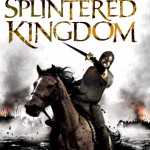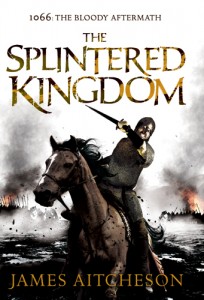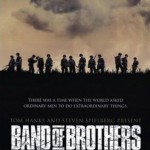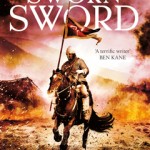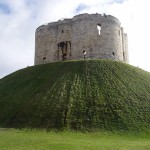Here it is! If you’ve been browsing online bookstores for the forthcoming sequel to Sworn Sword, you might already have caught a glimpse of it, but for those of you who haven’t, this is the jacket design for The Splintered Kingdom in all its glory.
Once again the cover illustrator Tim Byrne and everyone on the team at my publisher, Preface, have done a great job. In lots of ways it represents a continuation of a theme from the cover to Sworn Sword, and I think it really captures a sense of the energy and drama, as well as some of the darkness, of the new novel, which will see Tancred tested as he never has been before. Some familiar characters will return – friends and foes – but he will also find himself facing fresh challenges as rebellion stirs up once more and the threat of imminent invasion looms. That’s all I’ll say for now!
The Splintered Kingdom is currently scheduled for release on 13 September 2012, but if you really can’t wait until then, the first chapter is contained within the paperback of Sworn Sword as a sneak preview. I’ll be releasing more details about the book and giving a taste of what’s in store over the next few months, so keep checking back here on the website or follow my updates on Twitter or Facebook.
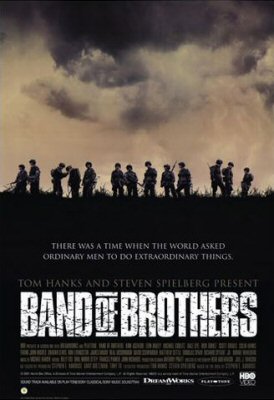
Promotional poster for the Second World War miniseries Band of Brothers, which was originally broadcast in 2001.
We few, we happy few, we band of brothers;
For he to-day that sheds his blood with me
Shall be my brother …
– William Shakespeare, Henry V, Act IV Scene iii
The idea of the “band of brothers” is central to Sworn Sword. The opening encounter at Durham sees Tancred’s conroi (the basic Norman cavalry unit, usually composed of around twenty men) shattered and his lord killed at the hands of Northumbrian rebels. Only two of his fellow knights, his close friends Eudo and Wace, survive to help him carry the stain of that defeat. The close group of warriors he once belonged to, who ate and trained and joked and fought together, is no more.
What happened to the real survivors of Durham is not recorded in the primary sources that mention the battle; indeed it is rare that the chronicles offer much by way of insight into the feelings of the people whose fates they record. Still, it is possible to imagine the grief and guilt and sense of loss those survivors had to bear, and the thoughts of revenge they must have harboured.
To capture a full sense of what it means to be part of such a tight-knit combat unit, I sometimes look to similar depictions elsewhere in fiction. One of the best portrayals I’ve come across is in the TV miniseries Band of Brothers. I first saw this series when it was originally shown in 2001, and watched it a second time a few years back when I was in the early stages of writing the novel that would become Sworn Sword.
With the second book, The Splintered Kingdom, now completed and my thoughts already turning to the next instalment of Tancred’s story, I went back to view the series on DVD again this week. Each time I’ve come to it with new eyes, and each time I’ve been able to take something away from it that either adds to my understanding of the hardships of war, or gives me ideas for fresh avenues to explore or new ways to depict the ongoing conflict that was the Norman Conquest in my writing.
The “band of brothers” of the series’ title is Easy Company of 2nd Battalion, 506th Parachute Infantry Regiment in the 101st Airborne Division of the U.S. Army. Over ten episodes we follow the exploits of the various characters – all based on real-life individuals – who make up the company, from their early training to Operation Overlord, and from there through Operation Market Garden and the Battle of the Bulge to the occupation of Germany at the end of the war.
The over-arching narrative of the 1944-5 campaign in Western Europe bears some similarities to that of the Norman Conquest. The series of operations which led from the Normandy landings to Berlin was long and arduous; progress was sporadic and frequently subject to German counter-offensives. Just as D-Day was only the beginning in June 1944, so the Battle of Hastings proved merely the opening engagement, albeit a highly significant one, in the Conquest.
Even though nearly 900 years separate the Second World War from my own period, there’s still a lot that can be learnt from Band of Brothers, not least regarding the experience of war and the psychology of those individuals who make it their business to fight. It’s fascinating to follow the journeys of the various characters and see how they each respond to the situations they find themselves in, and face up to challenges both physical and emotional.
We see green and untested volunteers develop into seasoned and skilled campaigners. Some appear to be natural warriors and born leaders, and find themselves in their element from the start, while others take time to find their feet. Some are strengthened by their experience of the war; others find themselves consumed by it, to the point where in order to make it through they sacrifice some of their humanity. One thing they have in common is that they are all changed by what they have seen and done.
War exacts its toll upon the individual in different ways, as I hope The Splintered Kingdom will show. As the battle for England intensifies and the kingdom falls under siege on all sides, the Normans’ grip on their hard-fought gains grows ever weaker, and in the middle of the struggle Tancred finds his resolve put to the test as never before.
Today the paperback of Sworn Sword hits the bookshelves! You’ll notice it has a brand new cover design (see bottom left), which really captures a sense of the drama contained within its pages and which I’m sure you’ll agree looks just as – if not more – striking than the original. Keep a look out for it in bookshops and supermarkets across the country.
The paperback also contains a sneak peek of the first chapter from the sequel, which is due out in hardcover and in all electronic formats this September. The title, I can reveal, will be The Splintered Kingdom. You heard it here first! More details, including the blurb and of course a picture of the jacket design, to follow in the not too distant future.
I’ll be signing copies of the Sworn Sword paperback in Waterstones in Hereford on Saturday 21 April, and I’m adding more dates to the calendar all the time, so keep checking my Events page to see if I’ll be appearing in your area in the coming months.
Also, if you’re a German speaker, look out for Der Pakt der Schwerter, which is set to be released on 17 April. Find out more on the website of my German publisher, Goldmann, and even read an excerpt.
Sworn Sword | Paperback | RRP £6.99 | Arrow | ISBN: 978-0-099-55941-2
Last week I ventured northwards to York for the annual Jorvik Viking Festival. For the 27th year, Norsemen took over the city for February half-term week and set up camp in the streets, even bringing their longship into Coppergate Square for those queueing up outside the Jorvik Viking Centre to admire.
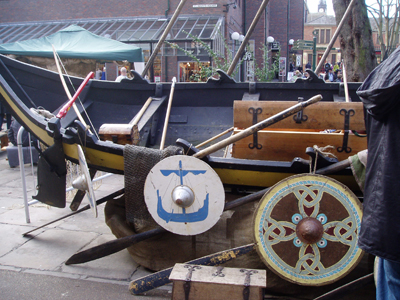
The Viking longship in Coppergate Square, outside the Jorvik Viking Centre.
I was in York to talk about Sworn Sword, the novel’s connection with the city, and what it was about York that made it such a battleground during the mid-eleventh century as English, Norman and Scandinavian forces all struggled to capture and control it. At the end I also gave a special sneak preview reading from the very first chapter of the sequel, which will be released in hardcover on 6 September (more details on that to follow soon).
York has a long history dating back to the Roman period. By the time of the Norman Conquest it was the second biggest city in England (after London): the chief town of the north of the kingdom; a major manufacturing centre for metalwork, woodwork, glass and jewellery; and a burgeoning port and trading hub with links all across Europe and beyond, even as far as Byzantium and Samarkand in modern-day Uzbekistan. In 1069 when Sworn Sword is set it would have been a fantastically vibrant place to be, with people from all cultures mixing together and a lot of wealth being brought in from abroad.
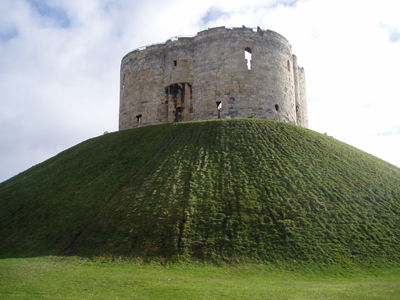
Clifford's Tower, York - the thirteenth-century keep that stands on the site of the original castle.
Militarily speaking, York was also a crucial strong-point, and whoever controlled it tended to hold sway over the vast province known as Northumbria that stretched from the Humber Estuary in the south to the borders of the Scottish kingdoms in the north.
For that reason it formed the location for some of the fiercest struggles for power witnessed in this period, both before the Conquest – the Battle of Stamford Bridge, for example, which was fought only a few miles away between the namesake kings Harold Godwineson of England and Harald Hardrada of Norway – and afterwards too. It’s not too much of an exaggeration to say that York was where in many ways the future of England was decided in those fateful years.
I visited the city a few years ago as part of my research for the novel, so that I could get a feel for the scale of the medieval city and the lie of the land. Not much of Conquest-era York survives today, but by walking the streets I was able to get a feel for the richness of the place’s history. On my return last week I also took the time to snap some pictures, the best of which you can see on this page!

The ruins of St Mary's Abbey outside Bootham Bar to the northwest of medieval York.
One of the locations that I revisited last week was St Mary’s Abbey (pictured above), the ruins of which now lie in the Yorkshire Museum Gardens. St Mary’s was in its turn built on the site of an earlier foundation dedicated to St Olave in a district once known as Earlsburgh, which it is suggested received its name from a fortified palace belonging to the Anglo-Scandinavian earls of Northumbria that used to stand nearby.
That palace is the same one referred to in Sworn Sword as the residence of the real-life vicomte (sheriff) of York, William Malet, who was installed by King William I after the city was first captured by the Normans in 1068. Even though the site looks very different nowadays, somehow the knowledge that I was treading the same ground as my characters helped me visualise those scenes when I came to write the novel.
Thanks to the folks at York Archaeological Trust and the Jorvik Viking Centre for inviting me to come and talk. It was a pleasure to meet so many other historically-minded people and to share my love of this period. I hope it’s not too long before I find myself back in York. And for those of you reading this who have a special interest in all things Norse-related, the good news is that there are more Vikings to come in Books 2 and 3 – watch this space!
*
For information about other Viking- and medieval-themed events taking place in and around York, visit the Jorvik Viking Centre website.

Cover image for Der Pakt der Schwerter, due to be published on 17 April 2012.
It’s Sworn Sword, but not as you know it.
On 17 April the German-language edition, entitled Der Pakt der Schwerter, will be hitting bookshelves across Germany, Austria and Switzerland. Published by Goldmann and translated by Jochen Stremmel, its 544 pages can be yours for the small sum of €9,99.
Goldmann have taken a different approach to the cover design to my UK publisher Preface, but I think you’ll agree the result is just as striking, evoking a sense of mystery as well as a lurking threat in the form of the the naked blade, both of which tie in nicely with the title, which in English translates as The Pact of Swords.
Here’s the cover blurb, for those among you who understand German:
Man schreibt das Jahr 1069. Drei Jahre sind vergangen, seit die Normannen England eroberten, doch ihre Herrschaft trifft noch immer auf erbitterten Widerstand. Der junge Ritter Tancred führt eine kleine Streitmacht ins rebellische Northumberland. Dort geraten seine Männer in einen Hinterhalt, bei dem sein Lehnsherr getötet wird. Statt diesem wird nun Tancred die Verantwortung für eine geheime Mission übertragen, von dessen gelingen das Schicksal des Königreiches abhängt.
And for those of you who don’t, here’s a translation, kindly supplied by Thomas Dyer:
The year is 1069. It’s been three years since the Normans conquered England, yet their rule is still encountering bitter resistance. The young knight Tancred leads a small troop of men into Northumberland, a county gripped by rebellion. It is there that his men fall victim to an ambush in which his feudal lord is killed. With his lord gone, it is now Tancred himself who is charged with a secret mission, on the success of which the fate of the kingdom depends.
I’ll post further pictures as soon as the first copies arrive. Until then, more information about the book can be found on the Verlagsgruppe Random House website.
17 April 2012 | Goldmann Verlag | ISBN: 978-3-442-47713-5 | €9,99 | Taschenbuch
With 2011 drawing to a close, I’ve chosen some of my favourite historically themed books of the past twelve months, both new releases and older titles recently discovered. Among my recommendations are works of both fiction and non-fiction, so with any luck there’s something in the list below to suit every taste. In no particular order, then, here are my personal picks of the year:
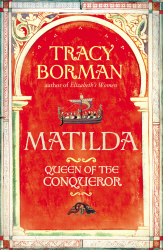 Matilda: Queen of the Conqueror
Matilda: Queen of the Conqueror
Tracy Borman
Jonathan Cape, 320 pp., £20
Hardback
Historian Tracy Borman delivers a brilliant account of the years either side of 1066, as seen through a new and largely unfamiliar lens: namely that of Matilda, the wife and queen of William of Normandy. Although relatively little is known about her life, Borman weaves the few facts that we do have into an engaging narrative of the Conquest, along the way providing insights into eleventh-century aristocratic and royal life, and the complex political webs that the ruling elite spun across north-western Europe. A highly readable and fascinating introduction to the subject of the Conquest.
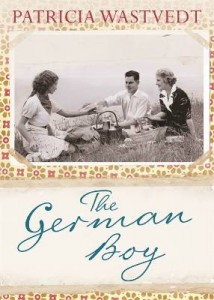 The German Boy
The German Boy
Patricia Wastvedt
Viking, 368 pp., £12.99
Paperback (large format)
Following on from the success of her debut The River, Patricia Wastvedt’s accomplished and compelling second novel takes place primarily in the interwar years of the early twentieth century, focussing on the complex relationships between two families as they come to terms with the momentous political events of the age. The prose is beautifully crafted, filled with lyrical descriptions, a keen sensitivity towards the characters and their sometimes difficult choices, and a sense of poignancy at roads untravelled. A delight to read: moving, thought-provoking and highly recommended.
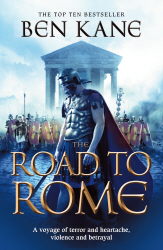 The Road to Rome
The Road to Rome
Ben Kane
Arrow, 608 pp., £6.99
Paperback
Concluding the story that The Forgotten Legion began, Ben Kane takes the reader back to Rome in the final years of Caesar’s dictatorship. The story follows the lives of three characters – two ex-slaves and an Etruscan haruspex or soothsayer – as they find themselves embroiled in the intrigues and conflicts of the time. The settings are vividly drawn and the moral dilemmas well explored as the characters are forced to decide where their loyalties lie. Also keep a look out for Kane’s latest, Spartacus: the Gladiator, which comes out next year.
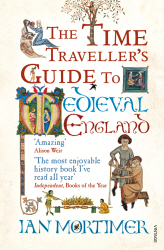 The Time Traveller’s Guide to Medieval England
The Time Traveller’s Guide to Medieval England
Ian Mortimer
Vintage, 368 pp., £8.99
Paperback
From the pen of historian Ian Mortimer comes an in-depth and accessible study of fourteenth-century life, ideal as an introduction to the period, and also (I imagine) a terrific resource for any historical novelists of the later Middle Ages. Assuming the perspective of a recently arrived visitor from our own time, Mortimer explores the workings of medieval English society, with chapters on everything from the landscape to food and drink, from health and disease to the law. Mortimer is also known for his Elizabethan mysteries under the pen-name James Forrester, and indeed a sequel of kinds to this book, The Time Traveller’s Guide to Elizabethan England, is due next year.
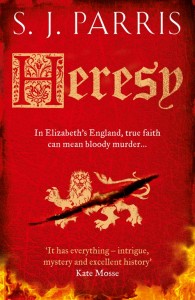 Heresy
Heresy
S J Parris
Harper, 512 pp., £7.99
Paperback
Speaking of Elizabethan mysteries, this debut offering from S J Parris deserves a mention. Narrated by Giordano Bruno, renegade monk, philosopher and spy, the tale unfolds in 1580s Oxford against a backdrop of murder, intrigue and religious strife. Fast-paced and with a keen sense of the issues of the age, it also happens to be the first in a series. The sequel, Prophecy, is already out in paperback and the third volume, Sacrilege, is set to be released in spring 2012.
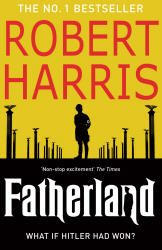 Fatherland
Fatherland
Robert Harris
Arrow, 400 pp., £7.99
Paperback
While not strictly a historical novel per se – Harris’ acclaimed thriller takes place in an alternate 1964, where Hitler won the Second World War – Fatherland is one of the most thrilling reads I’ve come across this year. What at first appears to be a straightforward murder investigation leads Kriminalpolizei detective Xavier March to uncover a conspiracy that runs to the very heart of the Nazi regime. Soon March finds himself in a race against time to expose the truth before the Gestapo catch up with him. If it sounds simple enough, think again. This is brilliantly constructed and thought-provoking stuff, crammed with twists and turns and with a denouement to remember.

